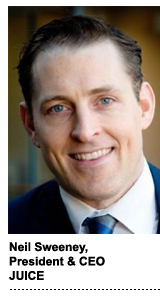 When YP Canada quietly acquired programmatic mobile ad platform JUICE Mobile for $35 million on March 17, its main concern was to assuage any potential investor concerns that the directory and listings behemoth wouldn’t be able to make its debt payments.
When YP Canada quietly acquired programmatic mobile ad platform JUICE Mobile for $35 million on March 17, its main concern was to assuage any potential investor concerns that the directory and listings behemoth wouldn’t be able to make its debt payments.
YP Canada was $1.7 billion in debt and teetering on the brink of bankruptcy in 2012. It underwent a restructuring to focus more on digital advertising and started to pay down its debt, pledging to be completely debt-free by 2018.
Now that the shareholders have been pacified, JUICE president and CEO Neil Sweeney was let loose to explain the rationale behind the deal.
In a word: mobile.
It’s a tough row to hoe for a historically old-school media company when print revenue is declining at a faster rate than digital revenue is growing.
In 2015, digital represented 58.6% of total revenue for Yellow Pages Ltd., the name YP Canada trades under as a public company on the Toronto Stock Exchange, up 9.8% year over year. At the same time, print, which composed the remainder of YP Canada’s revenue, declined at 21% for the year.
“They have the same problem that a lot of traditional businesses have,” Sweeney said. “They’re transitioning away from the legacy business, and they need to replace it with more digital revenue. It’s the same thing that’s happening with radio and newspapers.”
Making mobile programmatic advertising available to its mainstay of small and medium-size business clients is one way for YP to do that. Owning the tech also helps YP Canada gain mobile street cred as it transitions from a mostly service-oriented business to a player with product and recurring revenue.
“Everyone says they have to be more mobile, but you can’t just suddenly be more mobile – it doesn’t work like that,” Sweeney said.
If fits into the zeitgeist. Mobile spend in Canada overall is on a serious upswing. According to Montreal-based research company Ad Hoc, two in five marketers in Canada plan to increase their mobile spend in 2016, and eMarketer predicts that mobile will account for just over 48% of overall digital ad spend in Canada this year.
The acquisition folds YP’s digital marketing and performance media services arm, Mediative, into JUICE Mobile to create a single entity called JUICE that’s helmed by Sweeney. The Mediative name will be retired.
JUICE brings its self-service DSP Swarm to the table as well as a mobile programmatic direct platform called Nectar. Freckle IoT, a beacon network that JUICE spun off as a separate company in December 2014, wasn’t sold to YP as part of the JUICE acquisition, but it will likely be used to service YP clients down the line.
 On the Mediative side, there are three core components that make up the business: a shopper marketing group, a sales team devoted mainly to online advertising and SEO/SEM capabilities. (JUICE is taking on everything under the Mediative umbrella other than the search component, which will be absorbed back into YP.)
On the Mediative side, there are three core components that make up the business: a shopper marketing group, a sales team devoted mainly to online advertising and SEO/SEM capabilities. (JUICE is taking on everything under the Mediative umbrella other than the search component, which will be absorbed back into YP.)
Mediative has service, but “there isn’t a lot of technology” underpinning it all, Sweeney said.
Although it’s a bit early to determine exactly what the road map will look like for incorporating Mediative into JUICE, there are a number of what Yellow Pages Ltd. president and CEO Julien Billot referred to as “synergies” between the duo, like being able to reach consumers in the physical world.
In the near-term, though, it’ll be about using programmatic methods to buy more targeted, relevant leads at cheaper prices and giving SMBs the opportunity to buy mobile media programmatically through JUICE’s DSP.
But the first order of business above all else is to use some of YP’s financial backing – Mediative brings $50 million in revenue to JUICE’s $25 million – in order to double JUICE’s US headcount this quarter by bringing on 10 to 15 new people, mainly in sales.
Today, the total headcount of JUICE and Mediative together is a little over 200. Everyone is staying on board with the exception of now-former Mediative president Darby Sieben, who will take on a VP of strategy and partnerships role within the parent company.











